Leadership and Management Development Programme for ABC Company.
VerifiedAdded on 2023/06/05
|34
|5249
|83
Report
AI Summary
This report discusses the adoption of a leadership and management development programme for ABC Company, a tea processing industry where effective leadership is crucial for success. It examines the concept of leadership, the roles of a leader, leadership challenges, and the qualities of a successful leader, including focus, confidence, integrity, and innovation. The report also delves into management functions as defined by Henri Fayol, such as planning, organizing, commanding, coordinating, controlling, and staffing, highlighting the differences and similarities between leadership and management. It further explores situational and contingency theories of leadership, including Hersey and Blanchard's model and Goleman's model. The report also covers operations management, different approaches to operations management, and the role of a store manager in ABC Company, including inter-departmental communication, budget management, and asset management. Finally, it addresses external factors affecting the operation management of ABC Company, such as technological changes, competition, and government regulations, and their impact on decision-making.
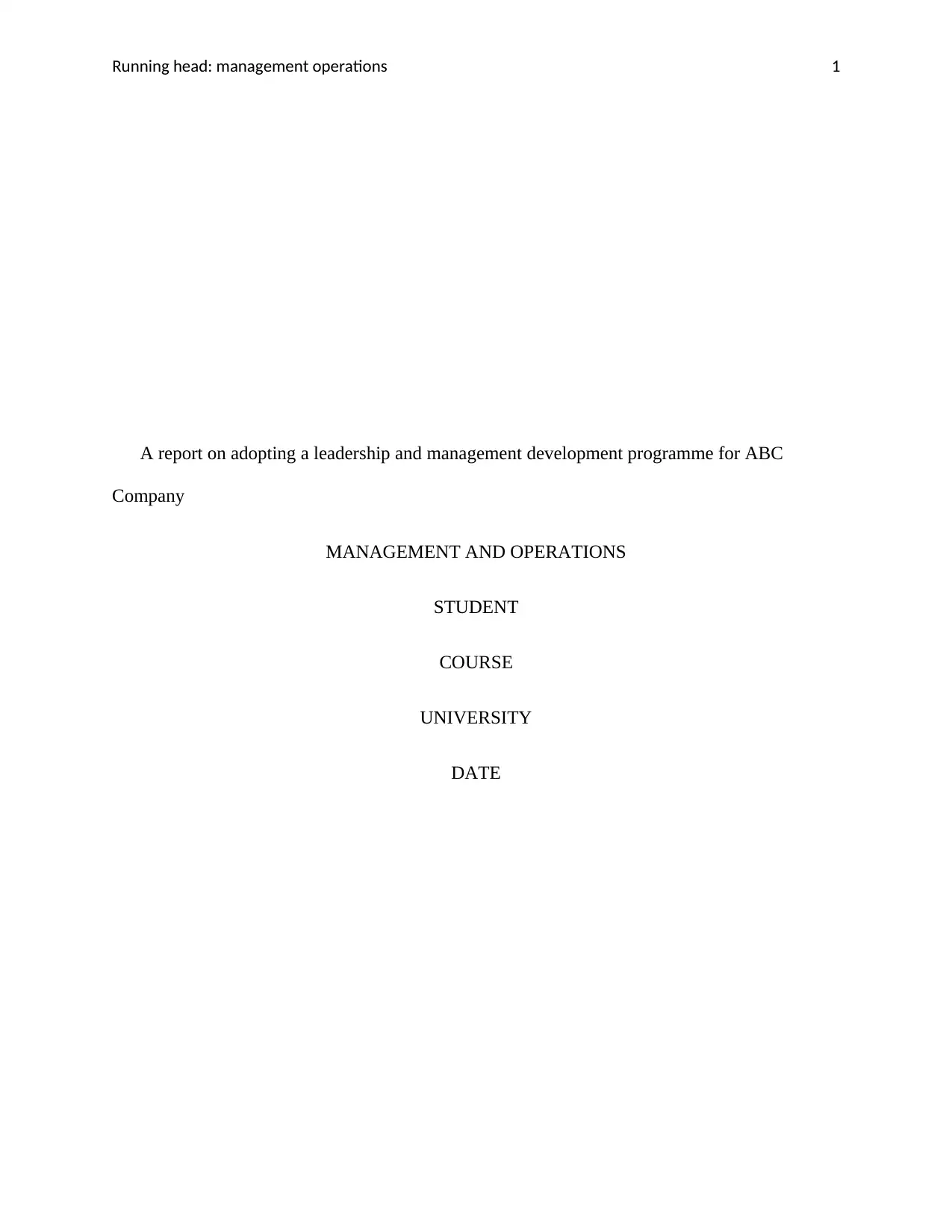
Running head: management operations 1
A report on adopting a leadership and management development programme for ABC
Company
MANAGEMENT AND OPERATIONS
STUDENT
COURSE
UNIVERSITY
DATE
A report on adopting a leadership and management development programme for ABC
Company
MANAGEMENT AND OPERATIONS
STUDENT
COURSE
UNIVERSITY
DATE
Paraphrase This Document
Need a fresh take? Get an instant paraphrase of this document with our AI Paraphraser
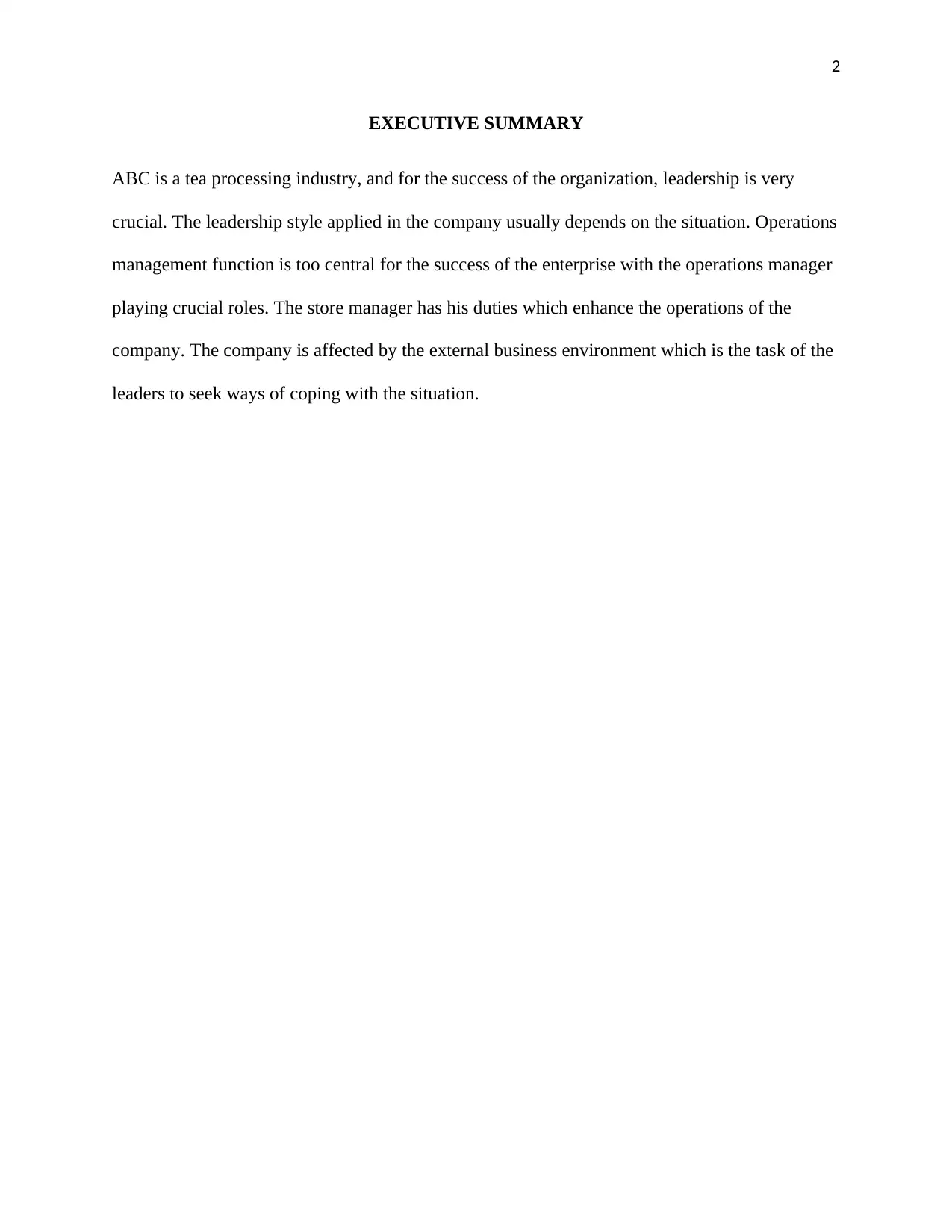
2
EXECUTIVE SUMMARY
ABC is a tea processing industry, and for the success of the organization, leadership is very
crucial. The leadership style applied in the company usually depends on the situation. Operations
management function is too central for the success of the enterprise with the operations manager
playing crucial roles. The store manager has his duties which enhance the operations of the
company. The company is affected by the external business environment which is the task of the
leaders to seek ways of coping with the situation.
EXECUTIVE SUMMARY
ABC is a tea processing industry, and for the success of the organization, leadership is very
crucial. The leadership style applied in the company usually depends on the situation. Operations
management function is too central for the success of the enterprise with the operations manager
playing crucial roles. The store manager has his duties which enhance the operations of the
company. The company is affected by the external business environment which is the task of the
leaders to seek ways of coping with the situation.
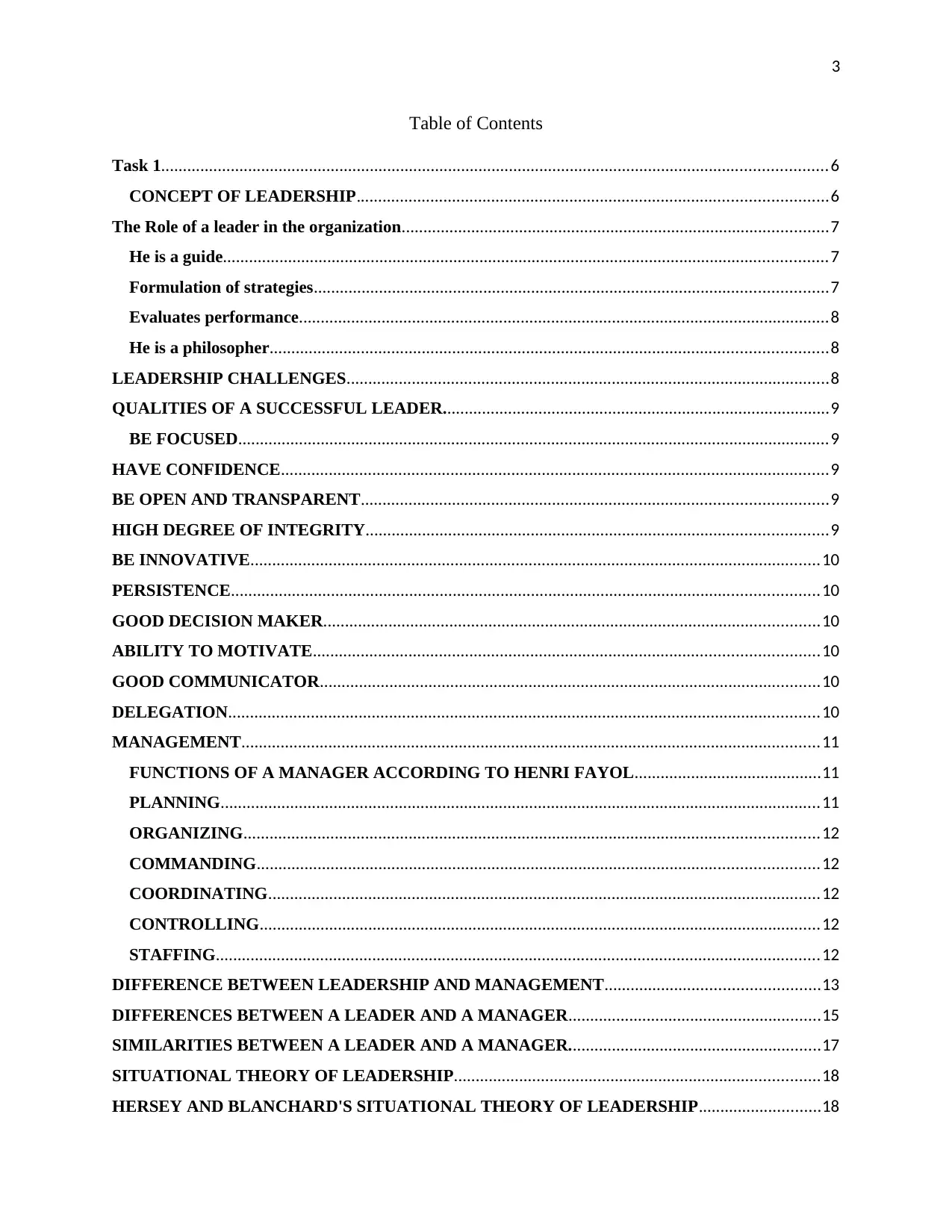
3
Table of Contents
Task 1.........................................................................................................................................................6
CONCEPT OF LEADERSHIP............................................................................................................6
The Role of a leader in the organization..................................................................................................7
He is a guide...........................................................................................................................................7
Formulation of strategies......................................................................................................................7
Evaluates performance..........................................................................................................................8
He is a philosopher................................................................................................................................8
LEADERSHIP CHALLENGES...............................................................................................................8
QUALITIES OF A SUCCESSFUL LEADER.........................................................................................9
BE FOCUSED........................................................................................................................................9
HAVE CONFIDENCE..............................................................................................................................9
BE OPEN AND TRANSPARENT...........................................................................................................9
HIGH DEGREE OF INTEGRITY..........................................................................................................9
BE INNOVATIVE...................................................................................................................................10
PERSISTENCE.......................................................................................................................................10
GOOD DECISION MAKER..................................................................................................................10
ABILITY TO MOTIVATE....................................................................................................................10
GOOD COMMUNICATOR...................................................................................................................10
DELEGATION........................................................................................................................................10
MANAGEMENT.....................................................................................................................................11
FUNCTIONS OF A MANAGER ACCORDING TO HENRI FAYOL...........................................11
PLANNING..........................................................................................................................................11
ORGANIZING....................................................................................................................................12
COMMANDING.................................................................................................................................12
COORDINATING...............................................................................................................................12
CONTROLLING.................................................................................................................................12
STAFFING...........................................................................................................................................12
DIFFERENCE BETWEEN LEADERSHIP AND MANAGEMENT.................................................13
DIFFERENCES BETWEEN A LEADER AND A MANAGER..........................................................15
SIMILARITIES BETWEEN A LEADER AND A MANAGER..........................................................17
SITUATIONAL THEORY OF LEADERSHIP....................................................................................18
HERSEY AND BLANCHARD'S SITUATIONAL THEORY OF LEADERSHIP............................18
Table of Contents
Task 1.........................................................................................................................................................6
CONCEPT OF LEADERSHIP............................................................................................................6
The Role of a leader in the organization..................................................................................................7
He is a guide...........................................................................................................................................7
Formulation of strategies......................................................................................................................7
Evaluates performance..........................................................................................................................8
He is a philosopher................................................................................................................................8
LEADERSHIP CHALLENGES...............................................................................................................8
QUALITIES OF A SUCCESSFUL LEADER.........................................................................................9
BE FOCUSED........................................................................................................................................9
HAVE CONFIDENCE..............................................................................................................................9
BE OPEN AND TRANSPARENT...........................................................................................................9
HIGH DEGREE OF INTEGRITY..........................................................................................................9
BE INNOVATIVE...................................................................................................................................10
PERSISTENCE.......................................................................................................................................10
GOOD DECISION MAKER..................................................................................................................10
ABILITY TO MOTIVATE....................................................................................................................10
GOOD COMMUNICATOR...................................................................................................................10
DELEGATION........................................................................................................................................10
MANAGEMENT.....................................................................................................................................11
FUNCTIONS OF A MANAGER ACCORDING TO HENRI FAYOL...........................................11
PLANNING..........................................................................................................................................11
ORGANIZING....................................................................................................................................12
COMMANDING.................................................................................................................................12
COORDINATING...............................................................................................................................12
CONTROLLING.................................................................................................................................12
STAFFING...........................................................................................................................................12
DIFFERENCE BETWEEN LEADERSHIP AND MANAGEMENT.................................................13
DIFFERENCES BETWEEN A LEADER AND A MANAGER..........................................................15
SIMILARITIES BETWEEN A LEADER AND A MANAGER..........................................................17
SITUATIONAL THEORY OF LEADERSHIP....................................................................................18
HERSEY AND BLANCHARD'S SITUATIONAL THEORY OF LEADERSHIP............................18
⊘ This is a preview!⊘
Do you want full access?
Subscribe today to unlock all pages.

Trusted by 1+ million students worldwide
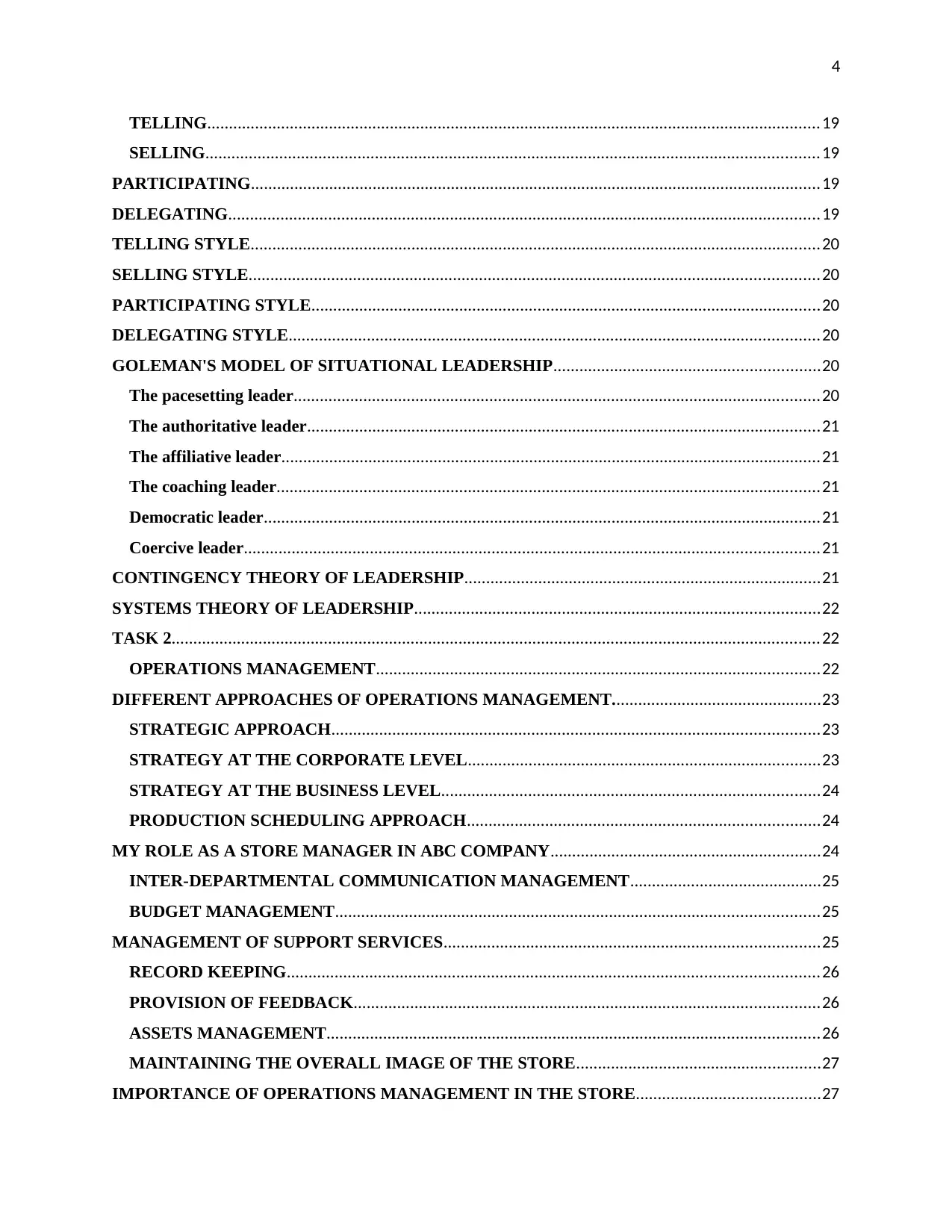
4
TELLING.............................................................................................................................................19
SELLING.............................................................................................................................................19
PARTICIPATING...................................................................................................................................19
DELEGATING........................................................................................................................................19
TELLING STYLE...................................................................................................................................20
SELLING STYLE...................................................................................................................................20
PARTICIPATING STYLE.....................................................................................................................20
DELEGATING STYLE..........................................................................................................................20
GOLEMAN'S MODEL OF SITUATIONAL LEADERSHIP.............................................................20
The pacesetting leader.........................................................................................................................20
The authoritative leader......................................................................................................................21
The affiliative leader............................................................................................................................21
The coaching leader.............................................................................................................................21
Democratic leader................................................................................................................................21
Coercive leader....................................................................................................................................21
CONTINGENCY THEORY OF LEADERSHIP..................................................................................21
SYSTEMS THEORY OF LEADERSHIP.............................................................................................22
TASK 2.....................................................................................................................................................22
OPERATIONS MANAGEMENT......................................................................................................22
DIFFERENT APPROACHES OF OPERATIONS MANAGEMENT................................................23
STRATEGIC APPROACH................................................................................................................23
STRATEGY AT THE CORPORATE LEVEL.................................................................................23
STRATEGY AT THE BUSINESS LEVEL.......................................................................................24
PRODUCTION SCHEDULING APPROACH.................................................................................24
MY ROLE AS A STORE MANAGER IN ABC COMPANY..............................................................24
INTER-DEPARTMENTAL COMMUNICATION MANAGEMENT............................................25
BUDGET MANAGEMENT...............................................................................................................25
MANAGEMENT OF SUPPORT SERVICES......................................................................................25
RECORD KEEPING..........................................................................................................................26
PROVISION OF FEEDBACK...........................................................................................................26
ASSETS MANAGEMENT.................................................................................................................26
MAINTAINING THE OVERALL IMAGE OF THE STORE........................................................27
IMPORTANCE OF OPERATIONS MANAGEMENT IN THE STORE..........................................27
TELLING.............................................................................................................................................19
SELLING.............................................................................................................................................19
PARTICIPATING...................................................................................................................................19
DELEGATING........................................................................................................................................19
TELLING STYLE...................................................................................................................................20
SELLING STYLE...................................................................................................................................20
PARTICIPATING STYLE.....................................................................................................................20
DELEGATING STYLE..........................................................................................................................20
GOLEMAN'S MODEL OF SITUATIONAL LEADERSHIP.............................................................20
The pacesetting leader.........................................................................................................................20
The authoritative leader......................................................................................................................21
The affiliative leader............................................................................................................................21
The coaching leader.............................................................................................................................21
Democratic leader................................................................................................................................21
Coercive leader....................................................................................................................................21
CONTINGENCY THEORY OF LEADERSHIP..................................................................................21
SYSTEMS THEORY OF LEADERSHIP.............................................................................................22
TASK 2.....................................................................................................................................................22
OPERATIONS MANAGEMENT......................................................................................................22
DIFFERENT APPROACHES OF OPERATIONS MANAGEMENT................................................23
STRATEGIC APPROACH................................................................................................................23
STRATEGY AT THE CORPORATE LEVEL.................................................................................23
STRATEGY AT THE BUSINESS LEVEL.......................................................................................24
PRODUCTION SCHEDULING APPROACH.................................................................................24
MY ROLE AS A STORE MANAGER IN ABC COMPANY..............................................................24
INTER-DEPARTMENTAL COMMUNICATION MANAGEMENT............................................25
BUDGET MANAGEMENT...............................................................................................................25
MANAGEMENT OF SUPPORT SERVICES......................................................................................25
RECORD KEEPING..........................................................................................................................26
PROVISION OF FEEDBACK...........................................................................................................26
ASSETS MANAGEMENT.................................................................................................................26
MAINTAINING THE OVERALL IMAGE OF THE STORE........................................................27
IMPORTANCE OF OPERATIONS MANAGEMENT IN THE STORE..........................................27
Paraphrase This Document
Need a fresh take? Get an instant paraphrase of this document with our AI Paraphraser
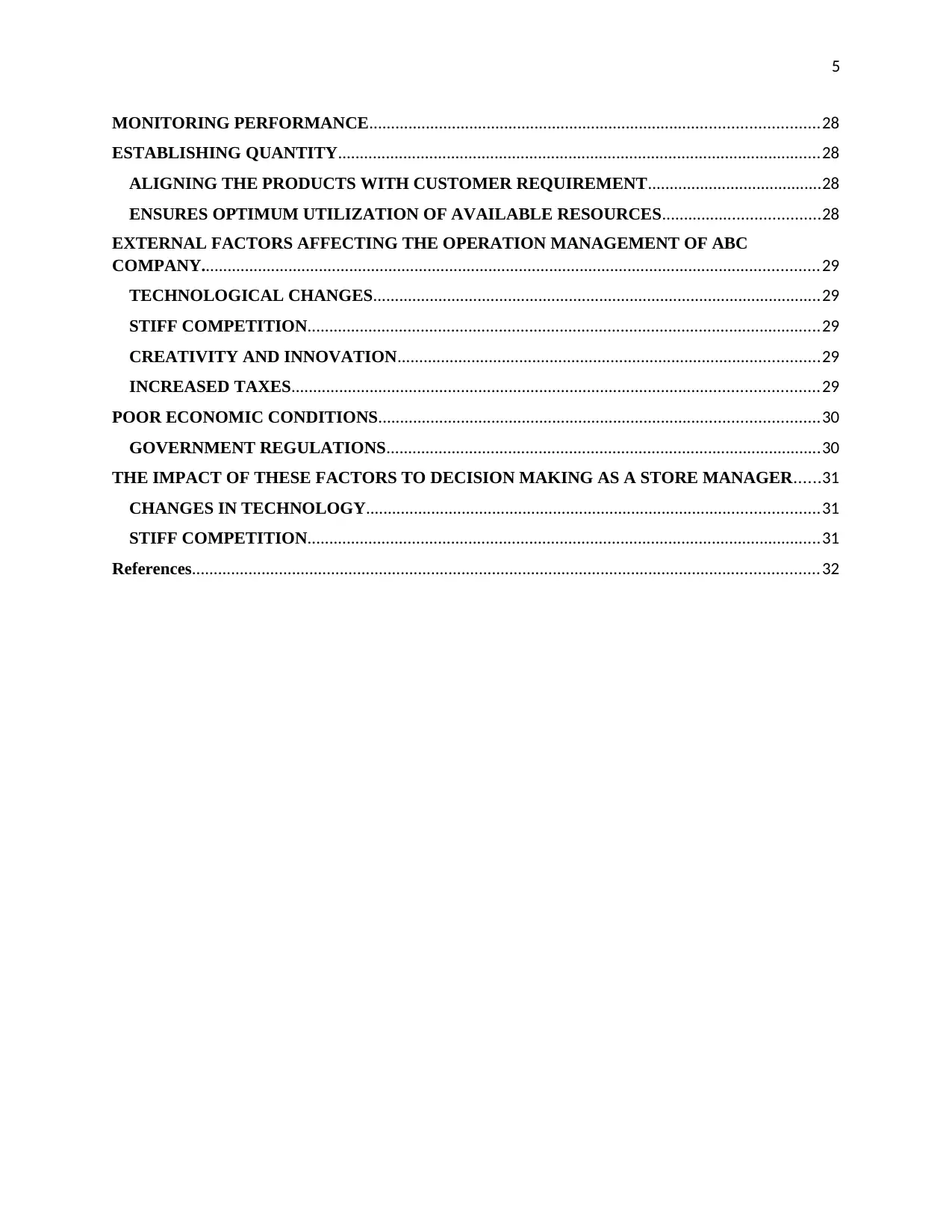
5
MONITORING PERFORMANCE.......................................................................................................28
ESTABLISHING QUANTITY...............................................................................................................28
ALIGNING THE PRODUCTS WITH CUSTOMER REQUIREMENT........................................28
ENSURES OPTIMUM UTILIZATION OF AVAILABLE RESOURCES....................................28
EXTERNAL FACTORS AFFECTING THE OPERATION MANAGEMENT OF ABC
COMPANY..............................................................................................................................................29
TECHNOLOGICAL CHANGES.......................................................................................................29
STIFF COMPETITION......................................................................................................................29
CREATIVITY AND INNOVATION.................................................................................................29
INCREASED TAXES.........................................................................................................................29
POOR ECONOMIC CONDITIONS.....................................................................................................30
GOVERNMENT REGULATIONS....................................................................................................30
THE IMPACT OF THESE FACTORS TO DECISION MAKING AS A STORE MANAGER......31
CHANGES IN TECHNOLOGY........................................................................................................31
STIFF COMPETITION......................................................................................................................31
References................................................................................................................................................32
MONITORING PERFORMANCE.......................................................................................................28
ESTABLISHING QUANTITY...............................................................................................................28
ALIGNING THE PRODUCTS WITH CUSTOMER REQUIREMENT........................................28
ENSURES OPTIMUM UTILIZATION OF AVAILABLE RESOURCES....................................28
EXTERNAL FACTORS AFFECTING THE OPERATION MANAGEMENT OF ABC
COMPANY..............................................................................................................................................29
TECHNOLOGICAL CHANGES.......................................................................................................29
STIFF COMPETITION......................................................................................................................29
CREATIVITY AND INNOVATION.................................................................................................29
INCREASED TAXES.........................................................................................................................29
POOR ECONOMIC CONDITIONS.....................................................................................................30
GOVERNMENT REGULATIONS....................................................................................................30
THE IMPACT OF THESE FACTORS TO DECISION MAKING AS A STORE MANAGER......31
CHANGES IN TECHNOLOGY........................................................................................................31
STIFF COMPETITION......................................................................................................................31
References................................................................................................................................................32
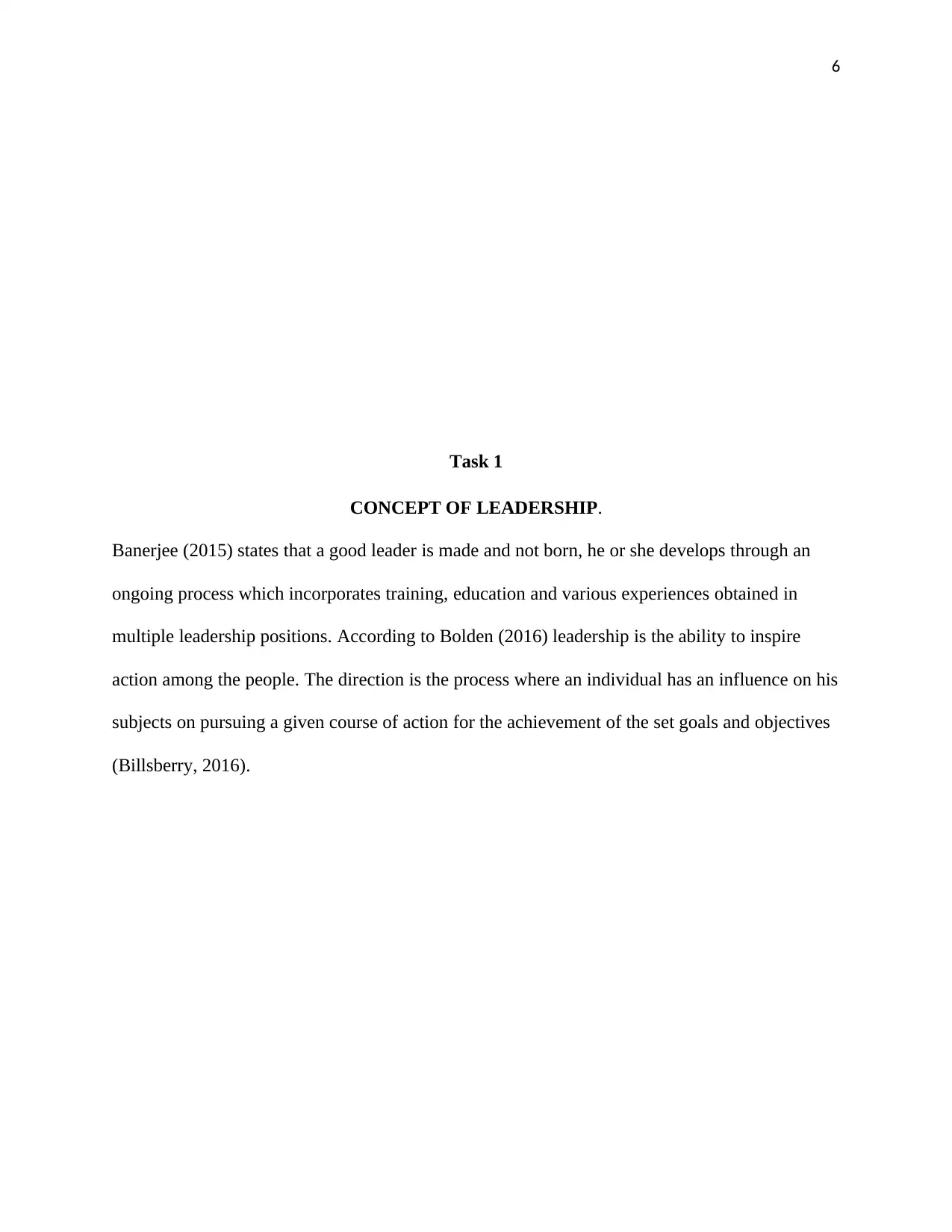
6
Task 1
CONCEPT OF LEADERSHIP.
Banerjee (2015) states that a good leader is made and not born, he or she develops through an
ongoing process which incorporates training, education and various experiences obtained in
multiple leadership positions. According to Bolden (2016) leadership is the ability to inspire
action among the people. The direction is the process where an individual has an influence on his
subjects on pursuing a given course of action for the achievement of the set goals and objectives
(Billsberry, 2016).
Task 1
CONCEPT OF LEADERSHIP.
Banerjee (2015) states that a good leader is made and not born, he or she develops through an
ongoing process which incorporates training, education and various experiences obtained in
multiple leadership positions. According to Bolden (2016) leadership is the ability to inspire
action among the people. The direction is the process where an individual has an influence on his
subjects on pursuing a given course of action for the achievement of the set goals and objectives
(Billsberry, 2016).
⊘ This is a preview!⊘
Do you want full access?
Subscribe today to unlock all pages.

Trusted by 1+ million students worldwide
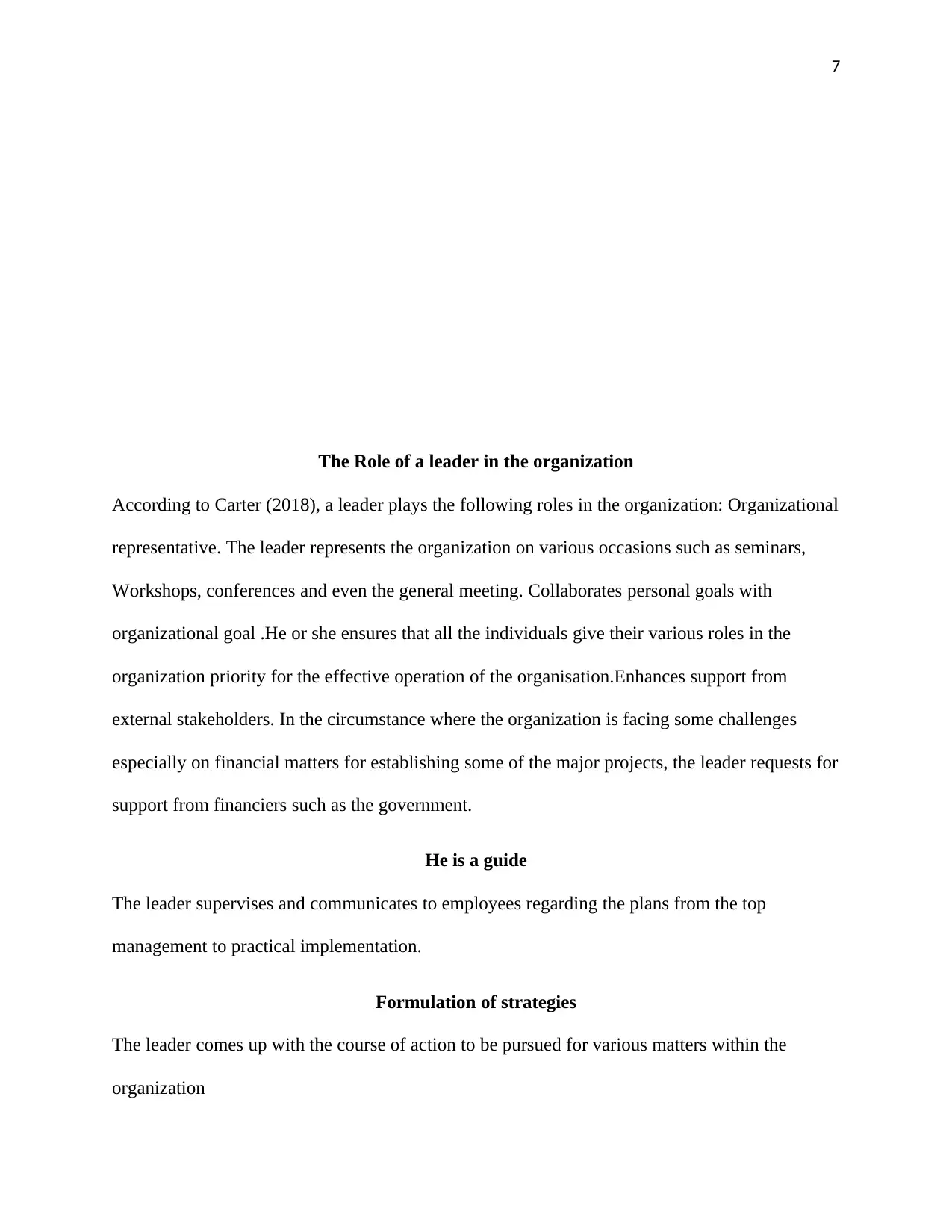
7
The Role of a leader in the organization
According to Carter (2018), a leader plays the following roles in the organization: Organizational
representative. The leader represents the organization on various occasions such as seminars,
Workshops, conferences and even the general meeting. Collaborates personal goals with
organizational goal .He or she ensures that all the individuals give their various roles in the
organization priority for the effective operation of the organisation.Enhances support from
external stakeholders. In the circumstance where the organization is facing some challenges
especially on financial matters for establishing some of the major projects, the leader requests for
support from financiers such as the government.
He is a guide
The leader supervises and communicates to employees regarding the plans from the top
management to practical implementation.
Formulation of strategies
The leader comes up with the course of action to be pursued for various matters within the
organization
The Role of a leader in the organization
According to Carter (2018), a leader plays the following roles in the organization: Organizational
representative. The leader represents the organization on various occasions such as seminars,
Workshops, conferences and even the general meeting. Collaborates personal goals with
organizational goal .He or she ensures that all the individuals give their various roles in the
organization priority for the effective operation of the organisation.Enhances support from
external stakeholders. In the circumstance where the organization is facing some challenges
especially on financial matters for establishing some of the major projects, the leader requests for
support from financiers such as the government.
He is a guide
The leader supervises and communicates to employees regarding the plans from the top
management to practical implementation.
Formulation of strategies
The leader comes up with the course of action to be pursued for various matters within the
organization
Paraphrase This Document
Need a fresh take? Get an instant paraphrase of this document with our AI Paraphraser
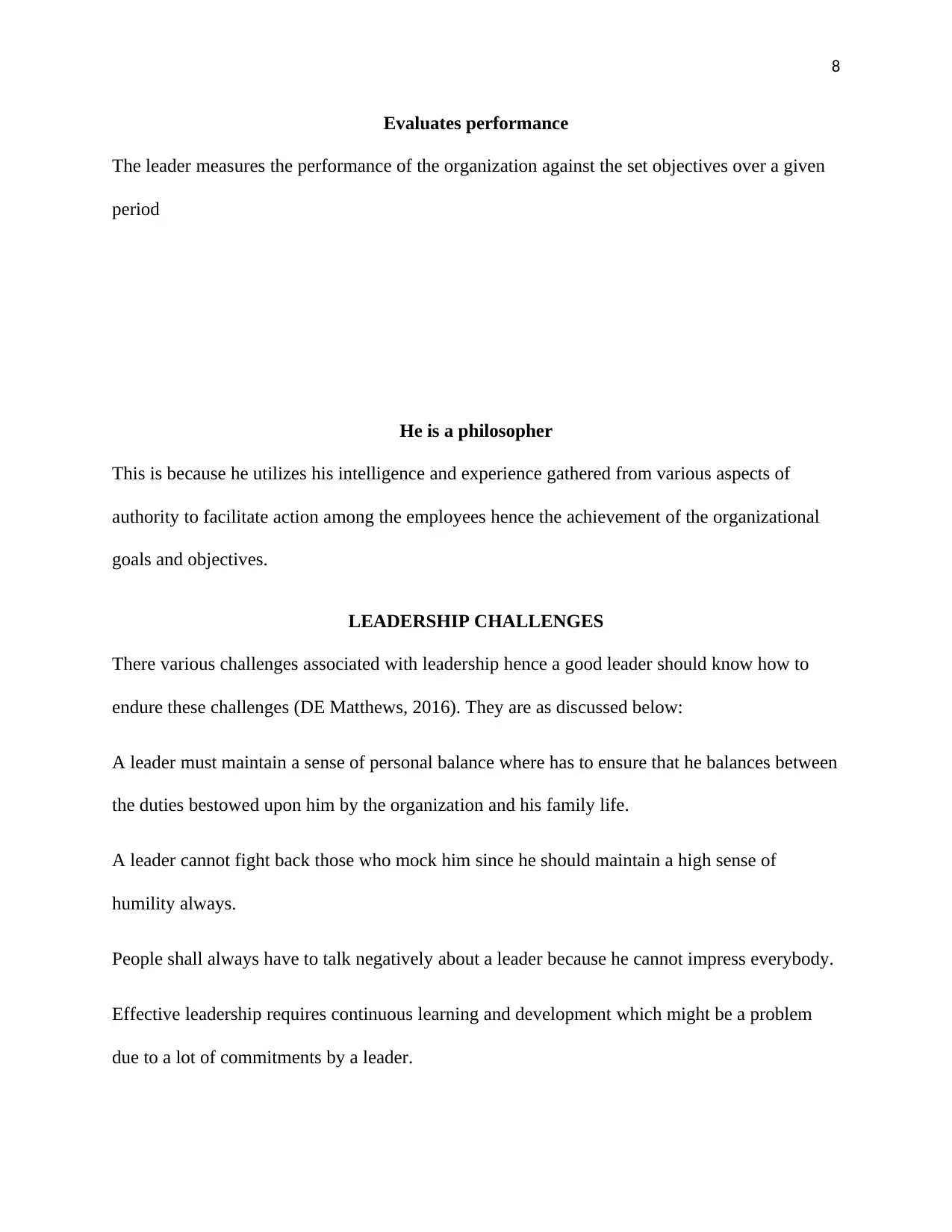
8
Evaluates performance
The leader measures the performance of the organization against the set objectives over a given
period
He is a philosopher
This is because he utilizes his intelligence and experience gathered from various aspects of
authority to facilitate action among the employees hence the achievement of the organizational
goals and objectives.
LEADERSHIP CHALLENGES
There various challenges associated with leadership hence a good leader should know how to
endure these challenges (DE Matthews, 2016). They are as discussed below:
A leader must maintain a sense of personal balance where has to ensure that he balances between
the duties bestowed upon him by the organization and his family life.
A leader cannot fight back those who mock him since he should maintain a high sense of
humility always.
People shall always have to talk negatively about a leader because he cannot impress everybody.
Effective leadership requires continuous learning and development which might be a problem
due to a lot of commitments by a leader.
Evaluates performance
The leader measures the performance of the organization against the set objectives over a given
period
He is a philosopher
This is because he utilizes his intelligence and experience gathered from various aspects of
authority to facilitate action among the employees hence the achievement of the organizational
goals and objectives.
LEADERSHIP CHALLENGES
There various challenges associated with leadership hence a good leader should know how to
endure these challenges (DE Matthews, 2016). They are as discussed below:
A leader must maintain a sense of personal balance where has to ensure that he balances between
the duties bestowed upon him by the organization and his family life.
A leader cannot fight back those who mock him since he should maintain a high sense of
humility always.
People shall always have to talk negatively about a leader because he cannot impress everybody.
Effective leadership requires continuous learning and development which might be a problem
due to a lot of commitments by a leader.
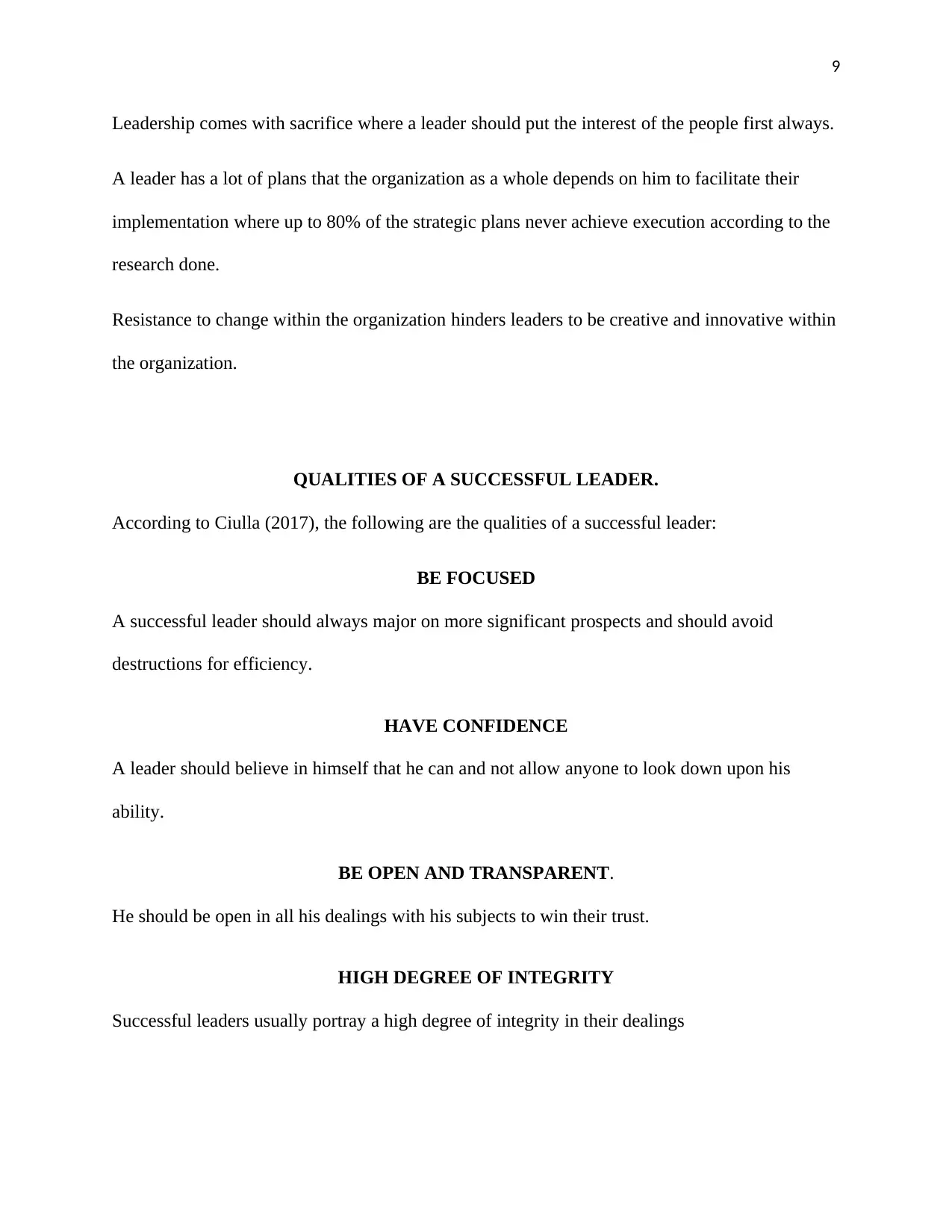
9
Leadership comes with sacrifice where a leader should put the interest of the people first always.
A leader has a lot of plans that the organization as a whole depends on him to facilitate their
implementation where up to 80% of the strategic plans never achieve execution according to the
research done.
Resistance to change within the organization hinders leaders to be creative and innovative within
the organization.
QUALITIES OF A SUCCESSFUL LEADER.
According to Ciulla (2017), the following are the qualities of a successful leader:
BE FOCUSED
A successful leader should always major on more significant prospects and should avoid
destructions for efficiency.
HAVE CONFIDENCE
A leader should believe in himself that he can and not allow anyone to look down upon his
ability.
BE OPEN AND TRANSPARENT.
He should be open in all his dealings with his subjects to win their trust.
HIGH DEGREE OF INTEGRITY
Successful leaders usually portray a high degree of integrity in their dealings
Leadership comes with sacrifice where a leader should put the interest of the people first always.
A leader has a lot of plans that the organization as a whole depends on him to facilitate their
implementation where up to 80% of the strategic plans never achieve execution according to the
research done.
Resistance to change within the organization hinders leaders to be creative and innovative within
the organization.
QUALITIES OF A SUCCESSFUL LEADER.
According to Ciulla (2017), the following are the qualities of a successful leader:
BE FOCUSED
A successful leader should always major on more significant prospects and should avoid
destructions for efficiency.
HAVE CONFIDENCE
A leader should believe in himself that he can and not allow anyone to look down upon his
ability.
BE OPEN AND TRANSPARENT.
He should be open in all his dealings with his subjects to win their trust.
HIGH DEGREE OF INTEGRITY
Successful leaders usually portray a high degree of integrity in their dealings
⊘ This is a preview!⊘
Do you want full access?
Subscribe today to unlock all pages.

Trusted by 1+ million students worldwide
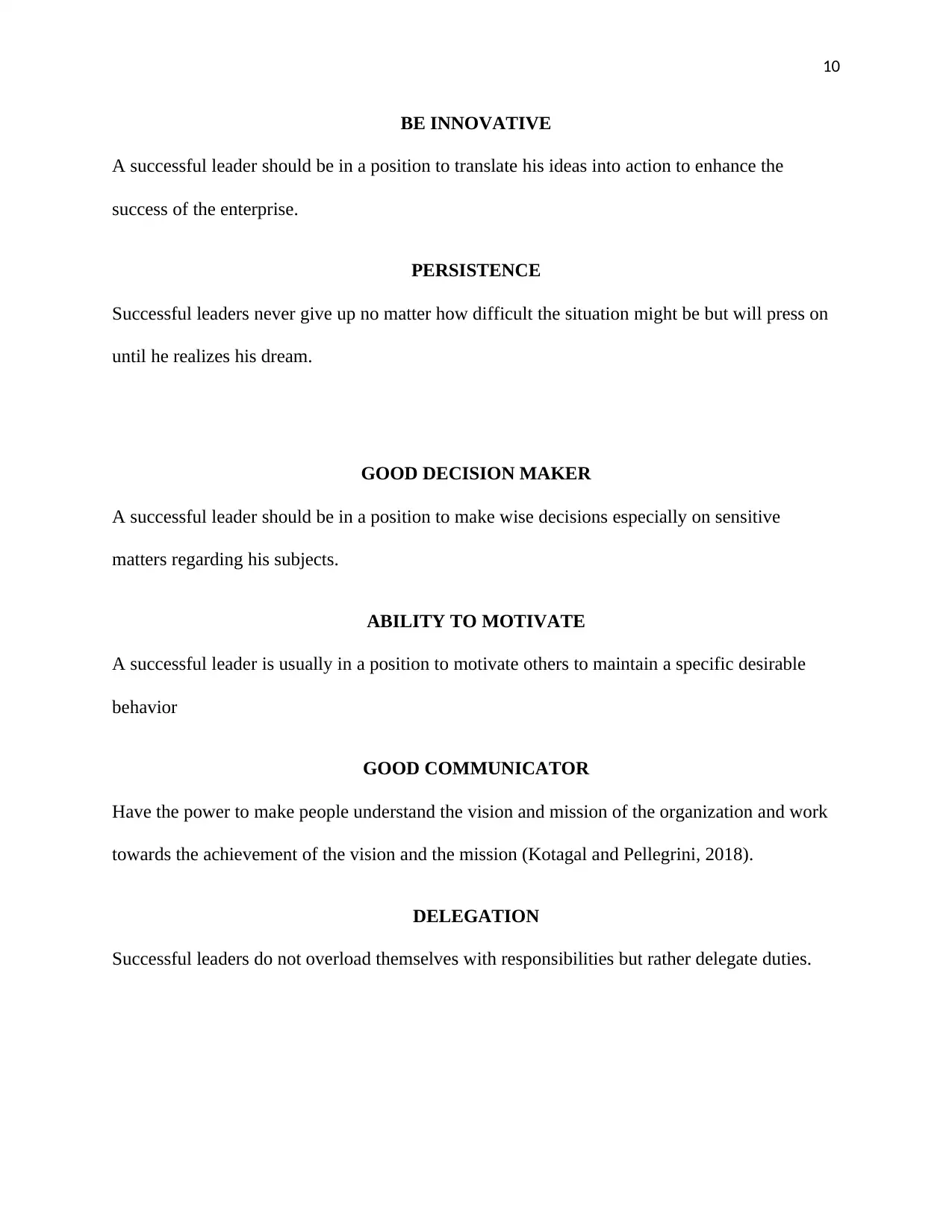
10
BE INNOVATIVE
A successful leader should be in a position to translate his ideas into action to enhance the
success of the enterprise.
PERSISTENCE
Successful leaders never give up no matter how difficult the situation might be but will press on
until he realizes his dream.
GOOD DECISION MAKER
A successful leader should be in a position to make wise decisions especially on sensitive
matters regarding his subjects.
ABILITY TO MOTIVATE
A successful leader is usually in a position to motivate others to maintain a specific desirable
behavior
GOOD COMMUNICATOR
Have the power to make people understand the vision and mission of the organization and work
towards the achievement of the vision and the mission (Kotagal and Pellegrini, 2018).
DELEGATION
Successful leaders do not overload themselves with responsibilities but rather delegate duties.
BE INNOVATIVE
A successful leader should be in a position to translate his ideas into action to enhance the
success of the enterprise.
PERSISTENCE
Successful leaders never give up no matter how difficult the situation might be but will press on
until he realizes his dream.
GOOD DECISION MAKER
A successful leader should be in a position to make wise decisions especially on sensitive
matters regarding his subjects.
ABILITY TO MOTIVATE
A successful leader is usually in a position to motivate others to maintain a specific desirable
behavior
GOOD COMMUNICATOR
Have the power to make people understand the vision and mission of the organization and work
towards the achievement of the vision and the mission (Kotagal and Pellegrini, 2018).
DELEGATION
Successful leaders do not overload themselves with responsibilities but rather delegate duties.
Paraphrase This Document
Need a fresh take? Get an instant paraphrase of this document with our AI Paraphraser
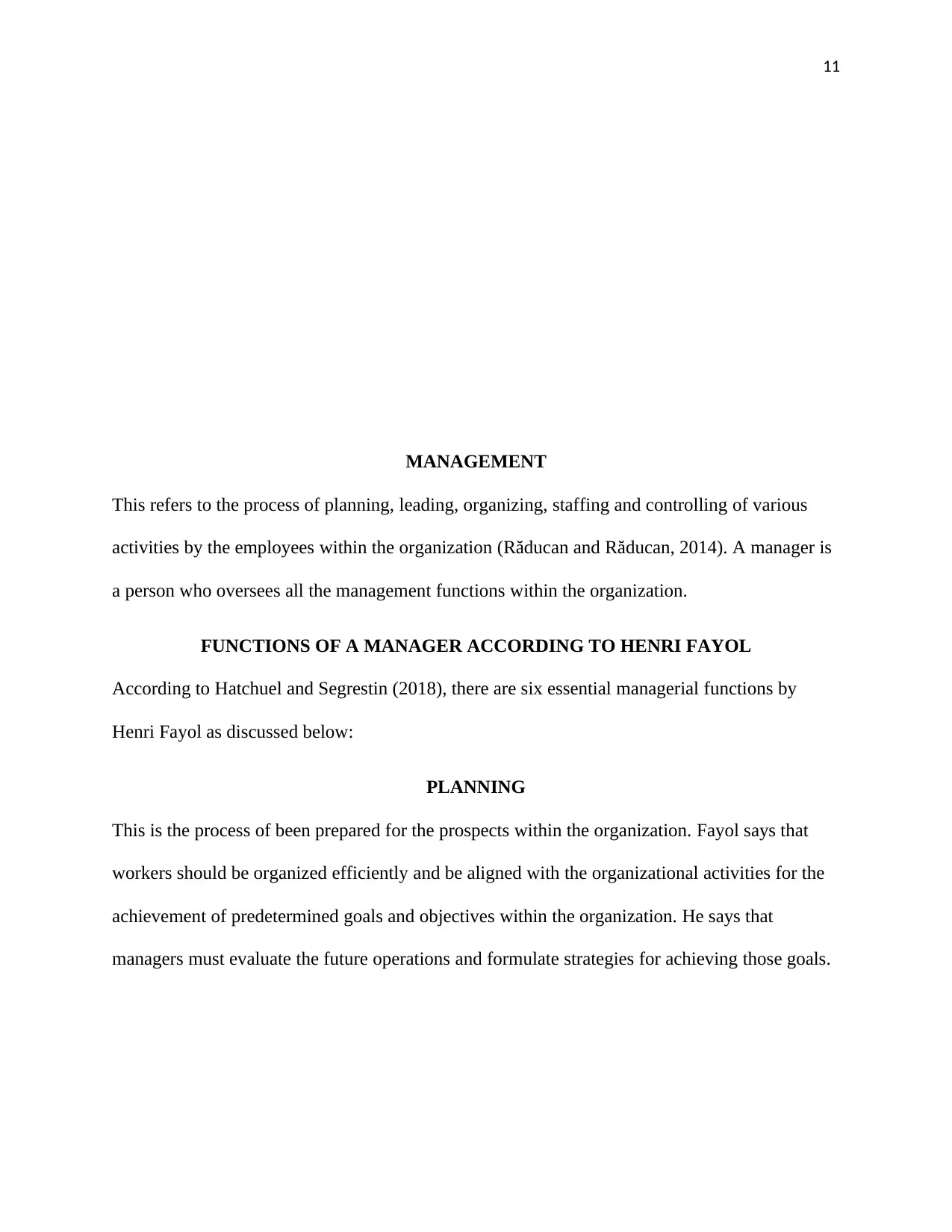
11
MANAGEMENT
This refers to the process of planning, leading, organizing, staffing and controlling of various
activities by the employees within the organization (Răducan and Răducan, 2014). A manager is
a person who oversees all the management functions within the organization.
FUNCTIONS OF A MANAGER ACCORDING TO HENRI FAYOL
According to Hatchuel and Segrestin (2018), there are six essential managerial functions by
Henri Fayol as discussed below:
PLANNING
This is the process of been prepared for the prospects within the organization. Fayol says that
workers should be organized efficiently and be aligned with the organizational activities for the
achievement of predetermined goals and objectives within the organization. He says that
managers must evaluate the future operations and formulate strategies for achieving those goals.
MANAGEMENT
This refers to the process of planning, leading, organizing, staffing and controlling of various
activities by the employees within the organization (Răducan and Răducan, 2014). A manager is
a person who oversees all the management functions within the organization.
FUNCTIONS OF A MANAGER ACCORDING TO HENRI FAYOL
According to Hatchuel and Segrestin (2018), there are six essential managerial functions by
Henri Fayol as discussed below:
PLANNING
This is the process of been prepared for the prospects within the organization. Fayol says that
workers should be organized efficiently and be aligned with the organizational activities for the
achievement of predetermined goals and objectives within the organization. He says that
managers must evaluate the future operations and formulate strategies for achieving those goals.
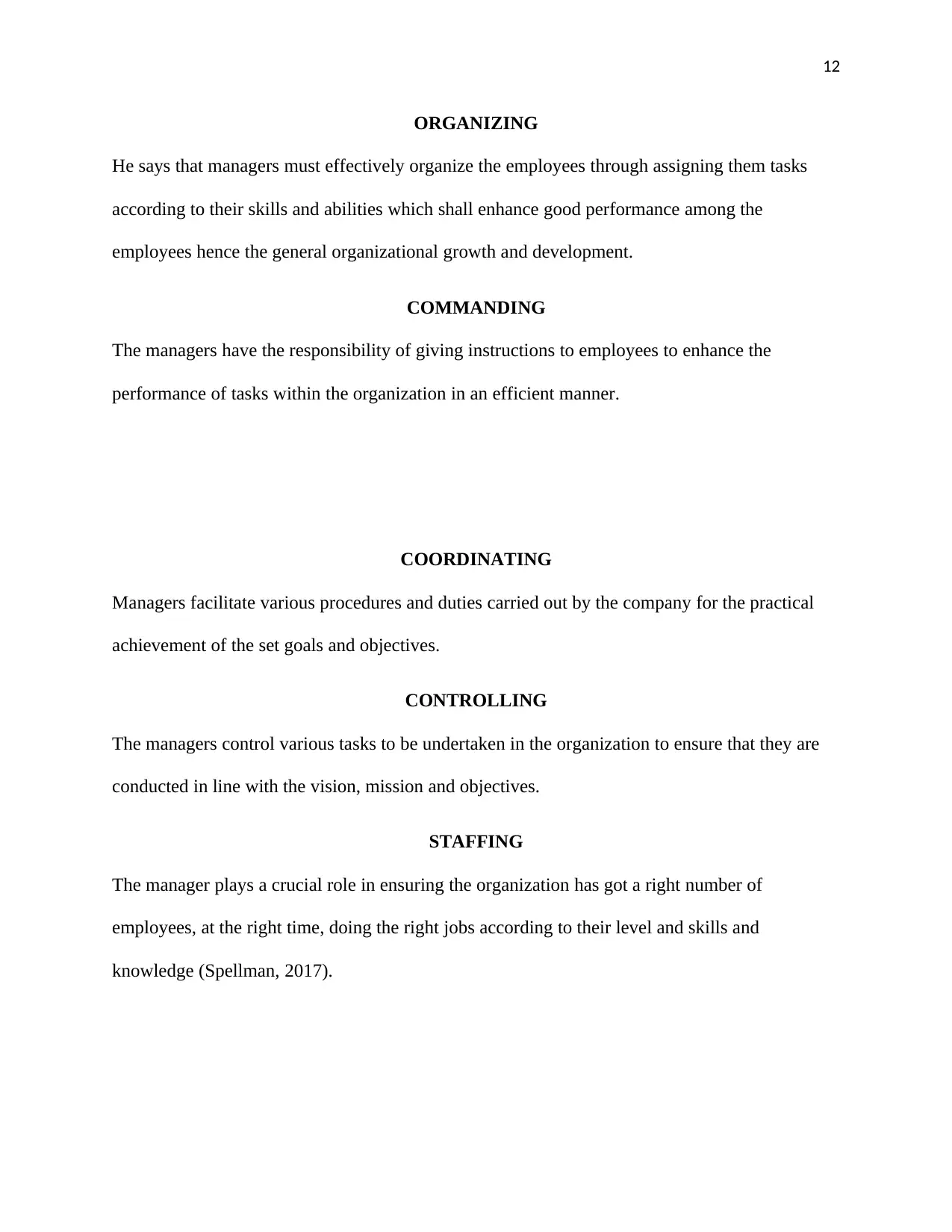
12
ORGANIZING
He says that managers must effectively organize the employees through assigning them tasks
according to their skills and abilities which shall enhance good performance among the
employees hence the general organizational growth and development.
COMMANDING
The managers have the responsibility of giving instructions to employees to enhance the
performance of tasks within the organization in an efficient manner.
COORDINATING
Managers facilitate various procedures and duties carried out by the company for the practical
achievement of the set goals and objectives.
CONTROLLING
The managers control various tasks to be undertaken in the organization to ensure that they are
conducted in line with the vision, mission and objectives.
STAFFING
The manager plays a crucial role in ensuring the organization has got a right number of
employees, at the right time, doing the right jobs according to their level and skills and
knowledge (Spellman, 2017).
ORGANIZING
He says that managers must effectively organize the employees through assigning them tasks
according to their skills and abilities which shall enhance good performance among the
employees hence the general organizational growth and development.
COMMANDING
The managers have the responsibility of giving instructions to employees to enhance the
performance of tasks within the organization in an efficient manner.
COORDINATING
Managers facilitate various procedures and duties carried out by the company for the practical
achievement of the set goals and objectives.
CONTROLLING
The managers control various tasks to be undertaken in the organization to ensure that they are
conducted in line with the vision, mission and objectives.
STAFFING
The manager plays a crucial role in ensuring the organization has got a right number of
employees, at the right time, doing the right jobs according to their level and skills and
knowledge (Spellman, 2017).
⊘ This is a preview!⊘
Do you want full access?
Subscribe today to unlock all pages.

Trusted by 1+ million students worldwide
1 out of 34
Related Documents
Your All-in-One AI-Powered Toolkit for Academic Success.
+13062052269
info@desklib.com
Available 24*7 on WhatsApp / Email
![[object Object]](/_next/static/media/star-bottom.7253800d.svg)
Unlock your academic potential
Copyright © 2020–2025 A2Z Services. All Rights Reserved. Developed and managed by ZUCOL.




